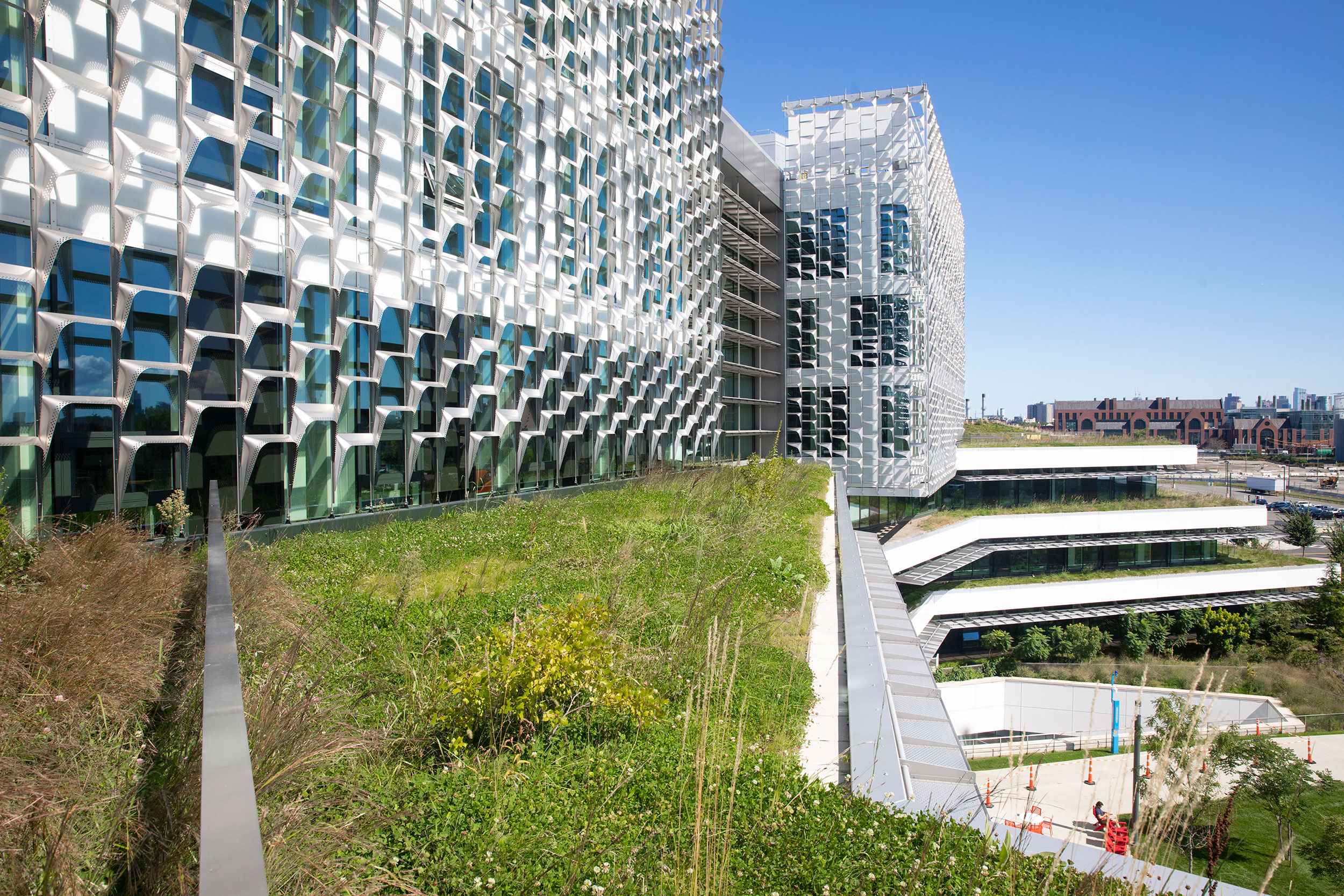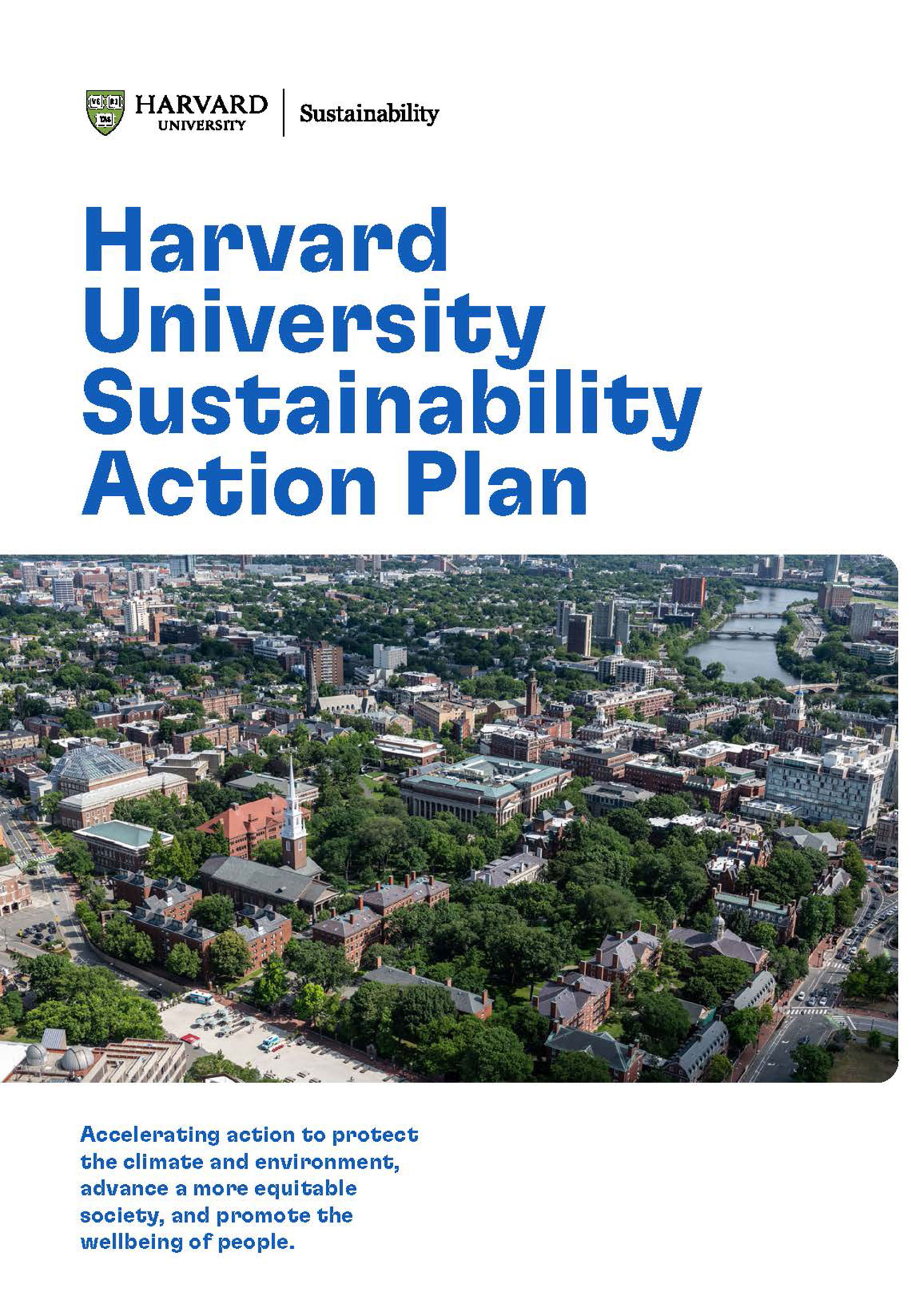
The Science and Engineering Complex incorporates natural sustainability features such as swales, constructed wetlands, and green rooftops.
Kris Snibbe/Harvard Staff Photographer
Keeping the plan sustainable
Harvard updates its flexible action plan to align with new priorities in climate, equity, and health
Harvard University today released its updated Sustainability Action Plan. First adopted in 2014, this strategic roadmap is built around three pillars of climate, equity, and health, and offers a unifying and holistic vision for creating a more sustainable institution, and in turn a more sustainable world.
“Harvard has a critical role to play in putting into practice the discovery and innovation that can combat climate change,” said Harvard University President Larry Bacow. “We are committed to advancing effective and scalable solutions that not only help us achieve our institutional goals but also create effective models for others to adjust and adopt. Our work in these areas is essential as humanity seeks to address growing challenges around the world.”
Harvard’s Sustainability Action Plan identifies priorities and strategies for accelerating action through its operations to protect the climate, advance a more equitable society, and promote the well-being of people now and in the future.
“With this inclusive and comprehensive institutional framework, we are advancing sustainability and climate action and solutions in how we operate and how we lead,” said Chief Sustainability Officer Heather Henriksen. “In updating this plan, we took a deeper look at how we can most significantly contribute to sustainable development through our operations and our campus. For example, we are thinking about the whole life cycle of our buildings and supply chain and working to address climate, equity, and health with our purchasing decisions which impact our local and global communities.”
“We are committed to advancing effective and scalable solutions that not only help us achieve our institutional goals but also create effective models for others to adjust and adopt.”
Larry Bacow, Harvard president
Developed by the Office for Sustainability with input from a wide array of University stakeholders, including the Presidential Committee on Sustainability, students, faculty, and operational and administrative leaders, the plan focuses on how Harvard powers, builds, operates, and leads.
“Students increasingly expect Harvard to lead on sustainability and climate issues. So it’s exciting to see this plan come out,” said Charles Hua ’23, who served on the Harvard Presidential Committee on Sustainability and the subcommittee that updated the action plan. “Being a part of this planning process made me further appreciate the critical role that students can play in accelerating sustainability and climate action on and off campus, both in everyday decisions and in the career paths we choose.”
The updated Sustainability Action Plan is intended to be a living document that provides flexibility over time as new technologies, strategies, and advancements, as well as challenges, emerge. The plan will be evaluated as the University’s work continues, and Harvard will provide progress updates as goals are attained and modified.
“The advances that have come forward since Harvard first put its initial plan in place nearly a decade ago are remarkable, including those innovations that came out of research and labs here at Harvard,” said Meredith Weenick, Harvard’s executive vice president. “Those breakthroughs have already enabled us to adapt the University’s plan in ways that may not have been envisioned a decade ago. As we continue to determine how we will address challenges like converting buildings to reduce emissions, it is critical that we are nimble and remain in a position to deploy and model new innovations and strategies.”
The major objective of Harvard’s plan remains Goal Zero. This science-based goal, set in 2018, involves eliminating the use of fossil fuels in Harvard’s district energy supply, buildings, purchased electricity, and vehicle fleet on campus by 2050.
Buildings currently account for 97 percent of the University’s emissions. Attaining Goal Zero will require Harvard to make complex decisions about how to transition away from fossil fuels to heat, cool, and power its buildings across campus. The transition to fossil-fuel-free for these complex, multi-use buildings will require large and disruptive capital infrastructure investments and electrification of hundreds of stand-alone buildings that do not operate on the district energy systems, according to the Sustainability Action Plan.
“In updating this plan, we took a deeper look at how we can most significantly contribute to sustainable development through our operations and our campus.”
Heather Henriksen, chief sustainability officer
In addition to Harvard’s 2050 Goal Zero, a near-term objective is for the University to be fossil-fuel-neutral by 2026. The University’s plans to meet the 2026 bridging goal include the purchase of renewable electricity and other projects that target the reduction of greenhouse gas emissions and other air pollution, which have significant health impacts.
“This plan lays out Harvard’s approach to piloting and sharing solutions that could provide road maps that other organizations can adopt at scale,” said Mike Toffel, Senator John Heinz Professor of Environmental Management, Harvard Business School, a co-chair of the Presidential Committee on Sustainability.
Since the launch of Harvard’s initial plan in 2014, several scalable solutions have spun out of this work.
In 2021, the University introduced its first fleet of 100 percent electric shuttle buses and in conjunction with the updates to this plan, is now committing to electrifying all shuttles by 2035 — other colleges are now emulating this pledge. Additionally, through a collaboration between the Office for Sustainability and faculty from the Harvard T.H. Chan School of Public Health and other graduate Schools, known as the Harvard Healthier Building Academy, the University has outlined and shared requirements for healthier building materials and indoor air quality in construction projects through Harvard’s Sustainable Building Standards. The academy aims to enhance the health of building occupants while reducing classes of chemicals of concern (e.g., PFAS) in the supply chain.

During the construction of its new Science and Engineering Complex (SEC), Harvard evaluated thousands of building materials and collaborated with 1,200 companies, ultimately motivating those companies to publicly disclose the ingredients in their products and create labels to help others make healthier decisions. The result led many manufacturing partners to reformulate their products to remove harmful classes of chemicals (e.g., PFAS “forever chemicals,” chemical flame retardants, etc.) for all customers. For this and many other reasons, the SEC was certified as one of the healthiest, most sustainable, and energy-efficient laboratories in the world after its completion in 2021, making it a model for future construction projects at Harvard and around the globe.
The plan also considers the impact of the steps Harvard is taking to ensure no one is left behind as the institution works to make the campus and the world more sustainable. Some ways Harvard is doing this is through the institution’s purchases, business partners, and how its facilities are operated.
“Even as we aim to achieve our big picture 2050 Goal Zero, our continued path to fossil-fuel-free and sustainable development includes a focus on holistic sustainability that addresses climate and the environment, equity, and well-being,” said Bill Clark, Harvey Brooks Research Professor of International Science, Public Policy, and Human Development at Harvard Kennedy School, and co-chair of the Sustainability Plan Subcommittee. “Our core sustainability vision is to enhance inclusive well-being in a way that does not jeopardize the ability of others elsewhere or in the future to advance their own well-being.”
To further the University’s efforts to advance and leverage the innovations and solutions being pursued by faculty and researchers to address the global challenges brought by climate change, the University established the Salata Institute on Climate and Sustainability in 2022 with a $200 million gift from Melanie and Jean Salata.
“As the impacts of climate change accelerate, Harvard University is responding with leadership and action. Our students, faculty, Harvard’s leaders, and the colleagues who make the University run are coming together like never before to help meet the climate challenge. This updated sustainability plan is critical to that effort,” said Jim Stock, Harvard’s first vice provost for climate and sustainability and director of the Salata Institute. “While Harvard University is adopting this new and dynamic sustainability plan, faculty across our campuses are forging new interdisciplinary collaborations that focus on some of the most challenging sustainability issues of our time.”




